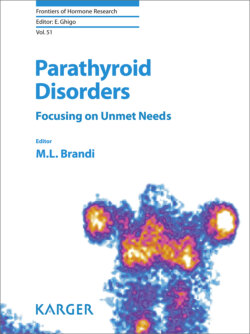Читать книгу Parathyroid Disorders - Группа авторов - Страница 22
На сайте Литреса книга снята с продажи.
Nonclassical Clinical Manifestations
ОглавлениеGeneral symptoms – in particular, fatigue, weakness, anxiety, and mood alterations – along with impairment in quality of life may affect patients with PHPT and may or may not improve after surgical cure [4].
Peptic ulcer disease, which used to be considered a frequent complication of PHPT, is now rarely seen and is almost exclusively detected in patients with MEN1 or MEN4 syndromes, who can develop gastrin-producing tumors [4]. With regard to cardiovascular health, hypertension, premature atherosclerosis, valve calcification, left ventricular hypertrophy, and arrhythmias have been reported in patients with PHPT.
Table 2. Spectrum of clinical signs of hyperparathyroidism according to organ systems
| Central nervous systemFatigueDepressionMemory impairmentDementiaPsychosisComa |
| GastrointestinalPeptic ulcer diseaseCholelithiasisPancreatitisConstipation |
| SkeletalOsteopenia – osteoporosisFracturesBone cysts – brown tumors |
| Neuromuscular and articularMyopathyGout – pseudogoutChondrocalcinosisErosive arthritis |
| CardiovascularHypertension – left ventricular hypertrophyShortened QT intervalArterial stiffnessArrhythmiasVascular and cardiac calcifications |
| RenalPolyuriaUrine concentrating defectNephrolithiasisRenal tubular acidosis |
| OcularCataractsBand keratopathy |
Severe PHPT characterized by higher serum calcium levels (calcium ≥11.2 mg/dL) has been associated with an increased risk of cardiovascular mortality [18]. Table 2 shows the spectrum of clinical features of hyperparathyroidism according to the organ system.
Table 3. Indication for surgery in PHPT
| Age <50 years |
| Serum calcium >1 mg/dL or >0.25 mmol/L of the upper limit of the reference interval for total calcium and >0.12 mmol/L for ion calcium |
| BMD T-score <–2.5 SD at the lumbar spine, femoral neck, total hip, 1/3 radius for postmenopausal women or males >50 years, or a prevalent low-energy fracture |
| GFR <60 mL/min. Evaluation of asymptomatic patients with renal imaging: X-ray, CT, or ultrasound Evaluation of stone risk profile in patients with urinary calcium excretion >400 mg/day If stone or nephrocalcinosis, surgery should be recommended |
